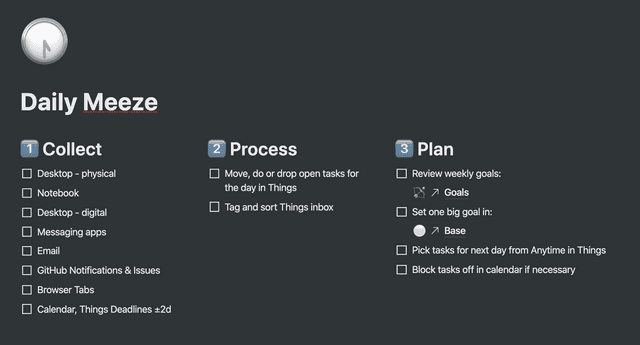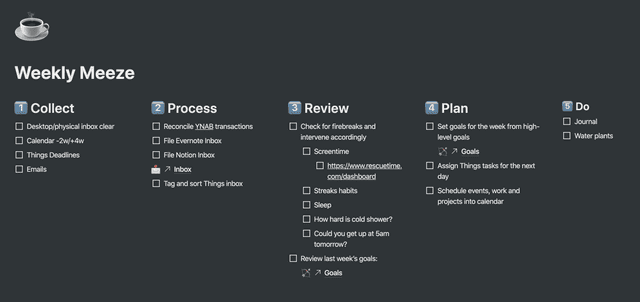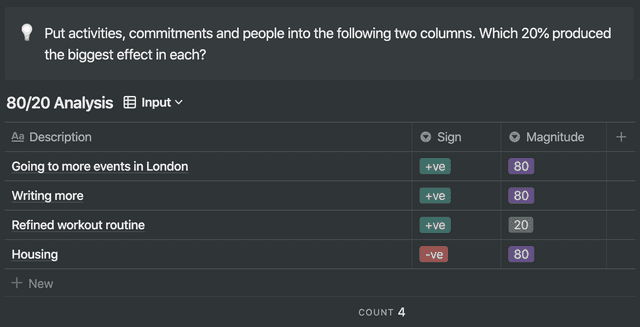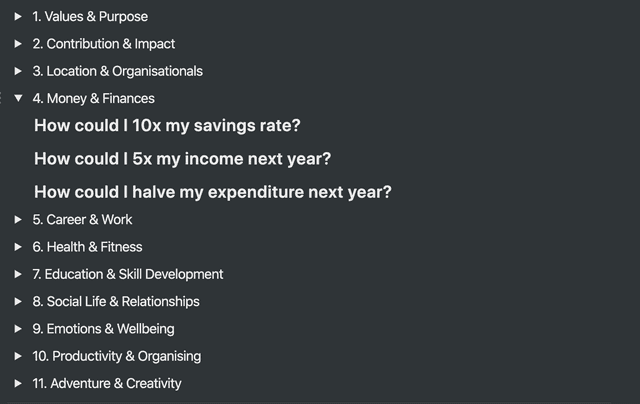The Cascading Productivity System
2020-02-02 • 1806 wordsAfter finding so many similar posts useful, I wanted to document and share my personal productivity system.
I call it the ‘cascading system’ as you can picture it as a multi-tiered waterfall, each level flowing down inform the one below it.
That said, the experience of using the system is more bottom-up and I find it helpful not only to define high-level goals and to work backwards from there but also to focus on the habit of doing first and then course correcting as appropriate. This means that I’ll be working from the most granular level upwards, explaining each new level as it naturally comes up from the one below it.
Table of Contents
Daily Meeze
At 18:00 on a typical workday, I do what I call the Daily Meezewhich takes the form of a checklist in Notion that looks like this:

I roughly follow the Getting Things Done methodology which was the inspiration for the three stages: Collect, Process and Plan.
The Collect stage cleans out all my information sources and adds all actions to my task manager inbox (for me, Things). More specifically, this means that:
- My desk is clean and all scraps of paper are recycled or captured digitally
- My physical notebook is reviewed with actions entered into Things and all notes digitised
- My email hits inbox zero
- I have no unread Slack, WhatsApp or iMessage messages
- I have read all notifications
- All browser tabs are closed (although I like saving collections of work in progress tabs with One Tab)
- I am aware of everything up in my calendar and process information from events earlier in the day
The next thing I do is Process. Tasks I have failed to accomplish that day (hopefully, zero!), tasks I’ve captured during Collect, as well as those I’ve been entering throughout the day get tagged and moved to the appropriate folder in Things. I add tags for importance (low, medium, high, top), required energy (high, medium-low, catatonic), environment (work, home) and duration (\<15mins, 15-60mins, 1hr+). I also clarify task names so that they are clearly actionable and delete any tasks that now seem unimportant.
The other important rule here is to do anything that takes less than two minutes immediately. The effort required to organise a task shouldn’t exceed the effort required to do it.
With keyboard shortcuts and practice, Process takes seconds.
The highest effort section of the Daily Meeze is Planning. Planning is hard because it is easy to overvalue unimportant tasks when you are still caught up in the day’s events. The planning fallacy also means that being over-optimistic about how much I can get done the next day is an easy trap to fall into. Over time, I developed a few strategies to avoid these issues.
First, I review my Weekly Goals from the level above in the cascade. This means my daily tasks are aimed at the most important thing, not just with whatever gets put in front of me that day.
Second, I ask myself ‘if I got nothing else done tomorrow, what would I be happy to have done?’ I set the answer to this as my one big goal for the day and type it in big letters in my Notion dashboard so that it is the first thing I see in the morning.
The Daily Meeze should be quick: mine takes ten to fifteen minutes if I’m on top of things. I am only able to do this because I keep the system lightweight. I used to have superfluous tasks like ‘Tweet learnings from the day’ and ‘document achievements in my journal’, but all tasks like this did was create noise and, when I was honest with myself, they never got done.
Another way to speed up your end of day process is to avoid overloading the definition of a task. Ideas are not tasks. Articles are not tasks. Broad questions to think through are not tasks. I have a place to put all these other things which could easily pollute my actions inbox: articles go in Instapaper; general documents and notes go in Evernote; business, app and other ideas go in my Notion inbox; problems to think through go in a list of journaling questions. If you struggle to answer the question ‘what is the first action for this task?’, you are almost certainly trying to file that item in the wrong place.
Weekly Meeze
For a long time, I thought about weekly reviews in the wrong way. Before I got this system working, weekly reviews were for positive action: goal setting, scheduling, journaling.
These are still essential components of my review today, but I view them with a different perspective.
Rather than thinking of the weekly review as a positive planning session, I now see it as a way to course-correct and stop myself from going off track. By clearing out the baggage from the previous week and giving myself a short moment of perspective, I find I can keep the longer-term goals in mind and keep my actions aimed where I want them to be.
My Weekly Meeze is of a similar format to my Daily Meeze and also has a checklist in Notion:

The weekly Collect stage helps catch anything missed from Daily Meezes from slipping through the cracks. Some inboxes also don’t get populated quickly enough to warrant a daily check-in, so I clean them out here.
After Collect, I do a quick batch of filing and organising. I check my finances, file any notes I’ve saved in Evernote or Notion and organise my Things tasks, just like in the Daily Meeze.
The Review section is where things diverge a little more from the daily process and it is the part of the review I find most valuable. One of the best tools I have found for reviewing is Sebastian Marshall’s ‘Firebreaks’. Firebreaks are checks you do to realise when things are potentially going off course and, if designed correctly, are excellent information feedback loops for your system.
Identifying good Firebreaks is mostly a matter of pattern matching on behaviours that correlate with poor productivity and wellbeing. There are some more obvious ones, like checking sleep quantity, but my favourite Firebreak is to ask myself “how happy would you be to get up at 05:00 and have a cold shower?” Now, I’m not saying I do this every day, but my response to this question captures a surprising amount about my health, motivation and productivity baselines at that time.
The Firebreaks section is essential for making my productivity system flexible and maintainable. If you have no feedback loops in your system, it is going to get out of control at some point. Checks like these allow me to calibrate how hard I’m working to how much of a break I need and to intervene early to prevent burnout.
With the Review stage still front of mind, I go on to set goals and schedules for the coming week. The cascade kicks in again here and I set my weekly goals based upon my higher-level goals.
With my goals set, I calendar in time to make progress on them (usually ~06:00 → 09:00 each morning) and set my Things tasks for the next day so that I’m ready to hit the ground running.
Finally, I note the week’s events in a journal and water my plants (somewhat irrelevant, but I don’t want them to die).
Quarterly Meeze
I don’t set quarterly goals. I think it would be quite odd if all goals happened to fit into neat, three-month chunks. Instead, I run my goals system continually and use my Quarterly Meezes as a moment of reflection.
The Quarterly Meeze is, for me, essentially a structured journaling
session. I review key metrics from the last three months (sleep,
time-tracking, habit tracking data, daily mood logs) and carry out a
quick 80/20 review of my activities so that I can do more of the good
and less of the bad.

I use this quantitative basis as a starting point to write freeform on how the quarter has gone. I move through three stages: Review, Visualise and Narrow. Hopefully, these are self-explanatory but, if you’re interested, you can find all my favourite journaling questions in the templates section at the bottom of this post.
Lastly, I turn the reflection into action and schedule any tasks and events that will give me tangible improvements form my reflection time.
Going to a new coffee shop and writing openly in this way is a very pleasant experience and I enjoy doing it slowly over a few hours do it to a sufficient depth.
Annual Meeze
The Annual Meeze is, obviously, the most in-depth section of my productivity system. As well as doing a complete quarterly review, I additionally spend time focusing on specific areas of my life so that I can pinpoint exactly what improvements to make.
I initially ran this section entirely from Alex Vermeer’s 8,760 Hours but the process has shifted slightly now that I’m in the third year of running it.
Like the Quarterly Meeze, the bulk of the Annual Meeze is subjective journaling. However, I also try and quantify the status in various areas of life with Likert scales, the scores from which are incredibly useful for comparing between years and pinpointing which areas to work on. They also help me to avoid over-investing where I am already doing well. For example, I scored highly on productivity last year so don’t need to invest as much time on it this year. Contrastingly, I hadn’t realised how much of an issue housing and organisationals caused me when I moved to London and consequently decided to work much harder on that area this year.

With a year ahead of me, I like to take the Annual Meeze as an opportunity to be optimistic about the future. I go to Daunt Books in Marylebone and browse the travel-based layout to inspire me to pick some good trips. I also plan festivals, gigs and other events far in advance so that I have a good backlog of things to look forward to.
It will be somewhat misleading to publish everything I’ve written here as a static entity when, in fact, the process is always changing. Yet while this is a work in progress, I’m quite happy with it as a stable foundation for future iterations.
Resources
If you are interested in implementing a similar system of your own, I’ve made a template for everything in this post in Notion, here. If you don’t have Notion yet, you can sign up here (referral link).
If you would like to see a complete list of tools I use, both for this post and generally, I maintain a list on this site at /uses.
